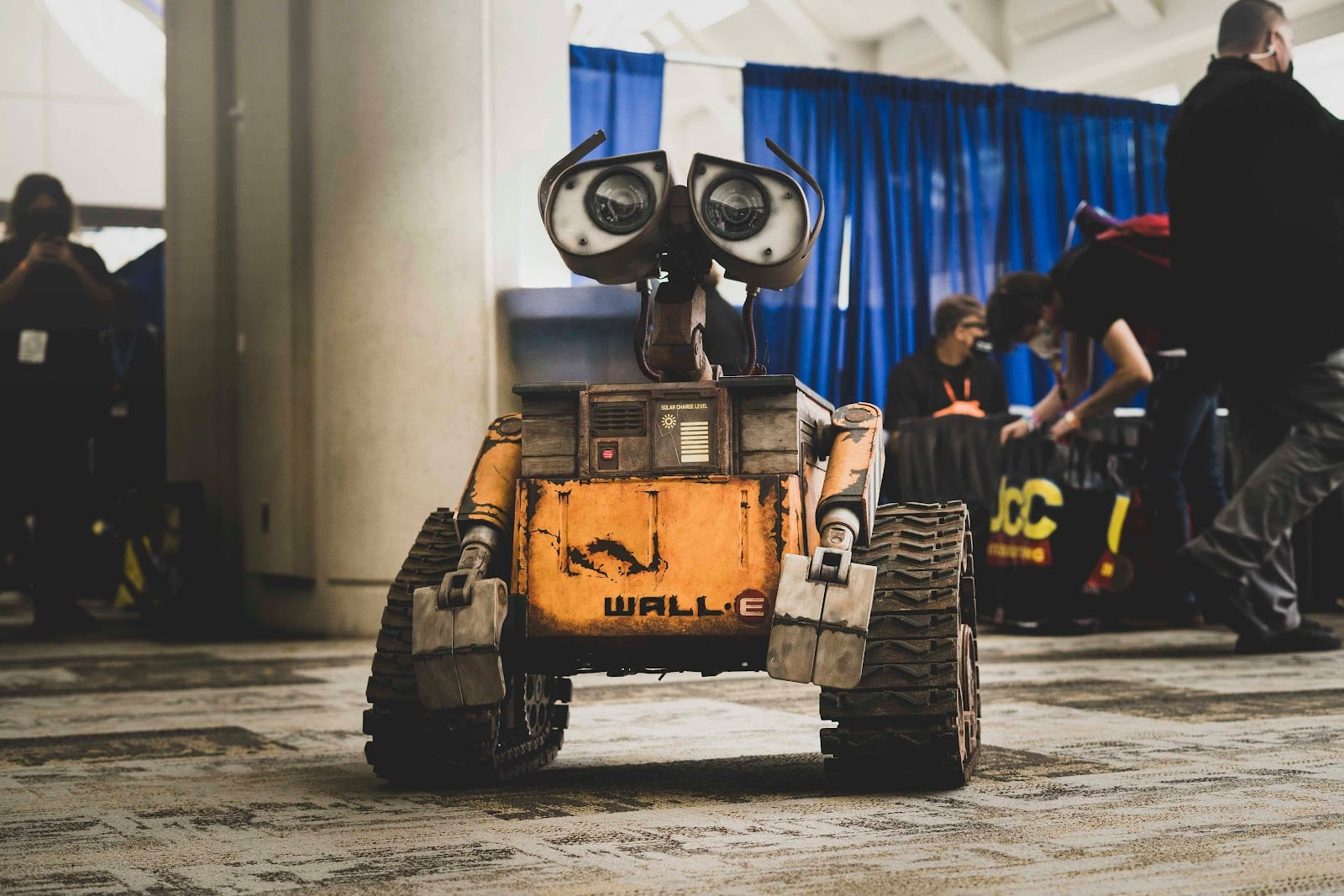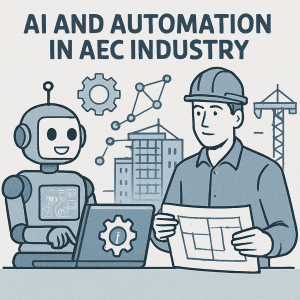Artificial Intelligence (AI) and automation are reshaping the AEC industry. This transformation is profound and far-reaching.
The integration of these technologies is altering job roles and responsibilities. It’s not just about replacing manual labor.
Automation in construction is enhancing efficiency and safety. It reduces the need for repetitive tasks.
Design automation tools are empowering architects and engineers. They can now focus more on creativity and innovation.
Machine learning in engineering is optimizing design processes. It improves project outcomes significantly.
The digital construction workforce is evolving rapidly. New skills and adaptability are essential to thrive.
Robotics in construction is taking on tasks like bricklaying and welding. This improves safety and productivity on-site.
The impact of AI on jobs is both challenging and exciting. It displaces some roles but creates new opportunities.
The Rise of AI and Automation in the AEC Industry
The AEC industry is witnessing a swift rise in AI applications. More firms are adopting automation to stay competitive.
Automation in construction is now a pivotal trend. It aids in enhancing precision and reducing costs.
AI technologies are not just about cutting expenses. They also boost safety and decrease human error.
The following trends are shaping the AEC industry:
- Integration of IoT and smart technologies
- Predictive maintenance using AI analytics
- Use of drones for surveying and monitoring
Machine learning and artificial intelligence engineering are becoming integral. They help in predictive analytics for complex projects.
The future of construction work will likely integrate more AI-driven tools. It’s an exciting and transformative period for the industry.
Key AEC Technology Trends Shaping the Workforce
Technology is reshaping how the AEC industry operates. New tools are changing traditional roles and job responsibilities.
AEC technology trends are moving towards sustainability and efficiency. Digital tools are pivotal to these changes.
The adoption of technology is not uniform across the industry. Some firms are quick to adapt, while others are slower.
Significant trends influencing AEC include:
- Green building and sustainable practices
- Advanced project management software
- Adoption of Building Information Modeling (BIM)
Design automation tools enhance creativity by reducing repetitive work. These trends are fostering a digital construction workforce.
Machine learning in engineering offers improved project outcomes. It optimizes design processes and decision-making.
Architects and engineers must adapt to these emerging tools. Embracing these technologies is essential for career longevity.
The evolution of the digital workforce is rapid and ongoing. Professionals must keep up with these dynamic trends.
Automation in Construction: Transforming On-Site Roles
Automation in construction is revolutionizing traditional on-site roles. This shift boosts efficiency, safety, and precision across projects.
Automation minimizes the need for manual labor in tedious tasks. Workers can focus more on complex and critical tasks.
Automated machines perform functions like bricklaying, welding, and demolition with exceptional speed. These technologies improve productivity and reduce errors.
Robotics and drones are becoming standard on construction sites. They help with tasks such as site inspections and material transport.
Key benefits of automation in construction include:
- Enhanced safety and reduced workplace accidents
- Increased project speed and efficiency
- Minimized material waste and resource optimization
Embracing automation requires adaptation from the workforce. Construction workers must learn to operate and maintain these new tools.
The integration of automation doesn’t eliminate the need for skilled labor. Instead, it shifts roles towards more tech-driven responsibilities.
As technology advances, the demand for tech-savvy workers will grow. This is vital for maintaining competitiveness in the industry.
Automation in construction is not just a trend; it’s a pivotal transformation. It prepares the industry for a more streamlined future.

Design Automation Tools and Machine Learning in Engineering
Design automation tools are reshaping engineering practices. They streamline workflows and enhance precision in complex projects.
These tools assist engineers in focusing on innovative solutions. Repetitive tasks are automated, allowing more time for creativity.
Machine learning is a key component driving these changes. It optimizes design processes, improving outcomes and reducing errors.
Engineers use machine learning to analyze vast datasets. This ensures optimal design solutions tailored to specific project needs.
Essential benefits of design automation tools include:
- Improved design accuracy and efficiency
- Enhanced collaboration through integrated design platforms
- Reduction in project timelines and costs
Machine learning also predicts maintenance needs. This proactive approach reduces downtime and extends the life of structures.
Despite automation, the human touch in engineering remains crucial. Engineers interpret data insights and make critical decisions.
Moreover, upskilling becomes essential as these tools evolve. Engineering professionals need continual learning to keep pace.
Design automation and machine learning are not merely add-ons. They are catalysts for innovation and efficiency in engineering.
Automation in Architecture: Evolving the Architect’s Role
Automation in architecture is shifting how architects approach design. It allows them to focus on creativity and complex problem-solving. Routine tasks like drafting and modeling are now more efficient.
Architects use automation for rapid prototyping and iterative design. These technologies streamline processes, offering more room for experimentation. As a result, projects can evolve faster and with higher precision.
Automation also enables architects to integrate sustainability considerations easily. By employing smart modeling tools, eco-friendly designs become more feasible. These tools suggest energy-efficient solutions that align with broader environmental goals.
The architect’s role is evolving to include digital proficiency and strategic planning. Understanding data and leveraging technology have become integral. Architects now must balance artistic vision with technical expertise.
Key advantages of architectural automation include:
- Speed in developing multiple design iterations
- Enhanced integration of sustainability parameters
- Greater focus on strategic and creative design aspects
As these trends persist, architects will continuously redefine their roles. They will need to embrace both traditional skills and new technologies.
Robotics in Construction: New Opportunities and Challenges
Robotics is revolutionizing the construction industry by handling tasks once considered too risky for humans. Robots are increasingly used for tasks like bricklaying and welding. These applications enhance productivity and safety on job sites.
The use of robotics can drastically cut down construction time. Projects are completed faster without compromising quality. Precision is another significant advantage, reducing errors that commonly occur with manual labor.
However, the adoption of robotics is not without its challenges. High initial costs can be a barrier for some companies. Additionally, there is a steep learning curve associated with operating and maintaining construction robots.
Despite these challenges, the benefits are pushing the industry forward. The role of human workers evolves to include managing and programming these machines. This shift requires significant upskilling for construction professionals.
Key opportunities and challenges with robotics include:
- Increased safety and productivity
- High initial investment and maintenance costs
- Need for enhanced worker skills and training
As the industry adapts, businesses must find ways to integrate robotics effectively. Those who do stand to gain a competitive edge in the evolving market.
The Impact of AI on Jobs: Displacement and Creation
AI is reshaping job dynamics in the AEC industry. Some roles face displacement due to increased automation. However, new opportunities are emerging in tech-centric areas.
Automation reduces the need for certain manual tasks. For instance, repetitive actions in construction can be automated. As a result, some traditional roles may diminish or disappear.
Conversely, AI creates new job opportunities requiring specialized skills. Tech-oriented roles in data analysis and system management are on the rise. These positions demand a deeper understanding of digital technologies.
While this shift may seem daunting, it provides growth potential. Workers who adapt to AI technologies can thrive in evolving roles. Continuous learning and skill development are crucial for staying relevant.
The balance between displacement and creation involves:
- Reduced demand for manual labor roles
- Rise of tech-focused positions
- Necessity for ongoing skill enhancement
Professionals must view AI as an asset rather than a threat. Embracing innovation can unlock new career avenues in the AEC industry.
The Digital Construction Workforce: Skills for the Future
The AEC industry is evolving towards a digital-first approach. As automation takes hold, new skills are essential. Digital literacy has become a baseline requirement for construction roles.
Understanding technology is no longer optional. Workers must familiarize themselves with digital tools and platforms. These skills are crucial for navigating a tech-driven environment effectively.
The digital construction workforce must embrace varied competencies. Analytical skills and critical thinking play vital roles. Adapting to new software and systems is another necessity.
Training and development programs are now paramount. These programs offer specialized courses and workshops. They focus on the latest industry trends and innovations.
Key skills for the digital construction workforce include:
- Proficiency in design software
- Data analysis and interpretation
- Basic coding knowledge
- Understanding of machine learning applications
- Communication skills in tech environments
Harnessing these skills leads to greater job security. Construction professionals can future-proof their careers. The focus on digital aptitude is shaping the construction workforce.
Adapting to AI Changes: Upskilling and Career Strategies
Adapting to AI’s integration in the AEC industry requires proactive action. Continuous learning has become a necessity for staying relevant. A commitment to education ensures career growth amid technological advancements.
Upskilling initiatives should focus on emerging technologies. Online courses and certifications offer valuable resources. These platforms provide insights into automation trends and tools.
Professionals need flexible career strategies to navigate change. Developing soft skills is equally important. Communication, adaptability, and problem-solving enhance collaboration with AI systems.
Networking within industry circles can reveal new opportunities. Engaging with thought leaders exposes professionals to innovative ideas. This engagement fosters a community ready to embrace AI-driven change.
Key strategies for adapting to AI include:
- Pursuing specialized certifications
- Attending industry conferences and workshops
- Engaging in continuous education
- Building a strong professional network
- Enhancing soft skills for adaptability
These strategies ensure professionals are well-equipped for AI’s impact. Embracing lifelong learning supports long-term career success. The AEC industry’s transformation brings challenges and opportunities.
The Future of Construction Work: Human-Machine Collaboration
The future of construction work lies in the synergy between humans and machines. Integrating AI into construction helps enhance efficiency and safety. Machines handle repetitive tasks, allowing workers to focus on complex problems.
Machines can assist with tasks like site surveys and material handling. AI-powered robotics improve speed and accuracy in construction processes. This technology collaboration leads to superior project outcomes.
Human oversight remains essential in construction. Workers are needed to manage AI systems and troubleshoot issues. Their expertise ensures technology aligns with project goals and quality standards.
Successful human-machine collaboration requires developing specific skills. Professionals should focus on areas where human intuition complements machine precision. This preparation will help achieve a balanced construction work environment.
Key elements of human-machine collaboration include:
- Effective communication between teams and technology
- Continuous learning to remain tech-savvy
- Strategic oversight and quality control
- Innovation-driven mindset for problem-solving
As the AEC industry evolves, embracing human-machine collaboration is crucial. This integration can lead to a construction workforce that’s more adaptable and capable.

Conclusion: Embracing the AEC Industry Transformation
The transformation of the AEC industry is in full swing. AI and automation technologies are key drivers of this evolution. Embracing these changes is essential for maintaining relevance.
Professionals must recognize the opportunities AI creates. By leveraging technology, they can achieve greater project efficiency and outcomes. This shift represents a significant advantage in the competitive landscape.
Continuous learning and adaptability are more crucial than ever. Technology advances rapidly, necessitating an ongoing commitment to skill development. Industry professionals must foster a mindset that welcomes innovation.
Collaboration between humans and machines is the future. This partnership enhances the construction process, merging human creativity with machine precision. The potential of this alliance is profound and transformative.
Ultimately, the AEC industry’s success will depend on how it integrates technology. Acknowledging the profound benefits of automation and AI can lead to unparalleled progress. Embracing transformation is not just necessary, it is a pathway to thriving in tomorrow’s world.





